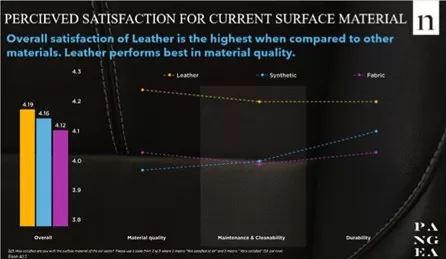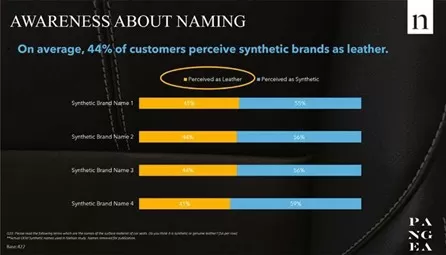In The News
Consumers Want Leather – Despite Media Coverage
October 31, 2022
By Randy Johnson, CEO
As one of the leading designers and manufacturers of leather for the global automotive industry, Pangea has been observing consumer perception and the growth of alternative materials. All materials have a place in the decision-making process and those decisions must be made freely, however it is also important that these choices are made with full awareness. With the growth of synthetic materials there has been a rise in confusion by consumers, leading them to believe that synthetic materials are genuine leather. This article explores Pangea’s research and observations on consumer beliefs, misrepresentation, and a suggestion on how we might collectively bring knowledge and truth into public awareness.
Consumers Love Leather
An important aspect of any business development is studying customers, and general consumer buying habits. Recently, Pangea surveyed OEM (original equipment manufacturers)customers, conducted dealer surveys, interviewed leather consumers, and analyzed globally published research. After aggregating statistics of thousands of people in Europe, Asia, and the United States, we found that consumers love leather.
Brands seek to meet emotional, value- based, and functional consumer needs. Leather has a unique, trendy, and historic way of meeting these buyer requirements, resulting in a definite attraction.
There are many interesting takeaways from recent studies showing consumers believe leather is premium and desirable.
One of which is “desire to purchase leather (vs. synthetic or fabric)”, according to a 2020Nielson study. 82% of customers from North America, Asia and Europe stated they would likely purchase leather seats in their next vehicle (Figure 1).
Leather is seen as a luxury material; and consumers expect it in certain applications. So much so, that imitation is everywhere. When consumers are in the premium car market or shopping for high-end sofas and chairs, they see leather as a necessity. When a consumer buys a car with a surface material that is leather-like, they naturally assume it is authentic leather. It is like a stamp of authenticity for luxury goods. Beyond a desire for luxury, consumers want natural materials that provide comfort, durability and cleanability. What does this mean?
 Comfort and Durability: Soft, natural feel, strong resistance to degradation. Materials that can maintain their “new car” look and feel, while aging well, providing pride of ownership to the consumer.
Comfort and Durability: Soft, natural feel, strong resistance to degradation. Materials that can maintain their “new car” look and feel, while aging well, providing pride of ownership to the consumer.
Cleanability: A characteristic amplified further through the global pandemic; leather’s easy-clean surface surpasses other materials cleanability year after year. This means the material is easy to clean, does not soak up spills and stains, is visibly less porous and naturally more germ resistant than cloth competitors.
These are the facts about consumers’ desire for authenticity, and leather meets these consumer expectations.
Studies also showed that consumers are willing to pay for luxury. In many markets, from automotive to furniture, people are paying for leather, only to find out they have PVC or PU instead.
 Deception
Deception
To be clear, our studies confirm that there is plenty of demand for leather, but sadly some of that demand is filled by deceptive marketing practices.
Synthetic surface material manufacturers generally want their materials to be seen as premium, promoting a false perception that their material is genuine leather, or as leather-like as possible. This is a core issue for our industry. When we look at companies that produce leather imitations, we they typically include the noble name of leather within their brand. Instead of stating it’s true composition, for example: “Polyvinyl Chloride” (PVC).
In the recent Nielson study, nearly half of consumers incorrectly perceived common synthetic brands as leather. Consumers are being misled, either accidentally or purposefully, and our industry has been slow to respond.
 There is significant risk to an automotive manufacturer if a consumer was to discover that their seats are not leather (when the consumer believed they were buying leather by trusting “leather like” names). 7% of consumers would definitely leave the brand and 58% would be compelled to consider other brands further.
There is significant risk to an automotive manufacturer if a consumer was to discover that their seats are not leather (when the consumer believed they were buying leather by trusting “leather like” names). 7% of consumers would definitely leave the brand and 58% would be compelled to consider other brands further.
This frustration is not unique to the automotive space, it is seen in the overall leather product market as well:
“A quarter (25%) said they would feel ripped off, 14% would be really upset and 13% would want their money back if they bought something that was marketed as “vegan leather” – and which they had therefore assumed to be all-natural –turned out to be completely or partly synthetic.”
– Consumer Attitude Towards Leather
– Leather Working Group Guest Post by Kerry Senior, Leather UK May 9, 2022
Leather Legalities
Europe has done the best job of driving regulation surrounding the use of the leather name, and spin-offs of the term. Legislation in some European countries is supporting the leather description and banning misuse. Austria, Belgium, France, Italy, Lithuania, Portugal, and Spain now prohibit using the word “leather” in non-leather applications and trade. In Italy, labelling is required on shoes, describing what the upper, sole, and lining material contains.
 Affiliated meat and hide associations are working on the same project in the United States to add labelling regulations in Washington DC. Current U.S. FTC regulations have documented guidelines for leather, but they omit auto, furniture and clothing. There is still much work to be done, including a major effort to get the regulations changed in the U.S. to follow suit for what is happening in Europe. There are also similar efforts in industry groups in Asia.
Affiliated meat and hide associations are working on the same project in the United States to add labelling regulations in Washington DC. Current U.S. FTC regulations have documented guidelines for leather, but they omit auto, furniture and clothing. There is still much work to be done, including a major effort to get the regulations changed in the U.S. to follow suit for what is happening in Europe. There are also similar efforts in industry groups in Asia.
Leather deception is a tricky thing to see outright. Therefore, consumer education is needed. To maintain the integrity of leather, an industry we care so deeply about, we must push the true narrative of leather and honesty in materials.
Our industry, due to its 400,000-yearexistence, has acquired some negative baggage. Commentators have taken advantage of this and are driving a negative leather narrative.
The reality is that leather is a brand on its own, consumers have a perception of what leather is, and it is our responsibility to protect it from imitation confusion and false narratives.
Call to action
We need to accept that synthetics are here to stay based on their cost proposition.
However, we do not need to accept synthetic products being called, either directly or implied, ‘leather’. It’s time for the automotive leather industry to connect with automotive consumers about innovations and genuine leather truthfulness.
We don’t need to attack the benefits of synthetics; our product speaks for itself in performance terms and alternatives have their own unique selling propositions. Find your social voice to promote innovation and truth and people will learn that the leather story is a good one. The400,000-year-old story about using everything possible after feeding our planet is more powerful and compelling than any anti-leather falsities.